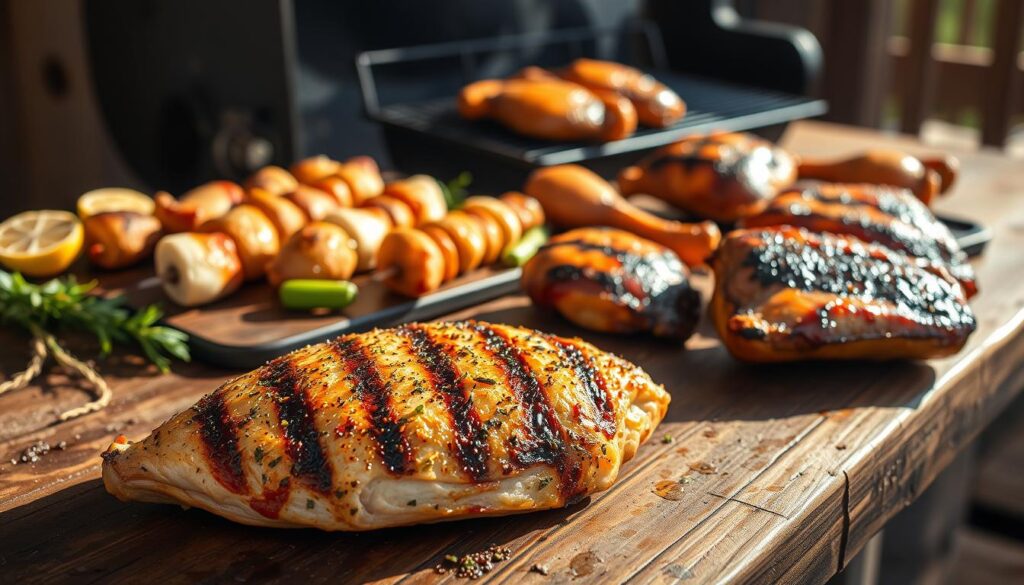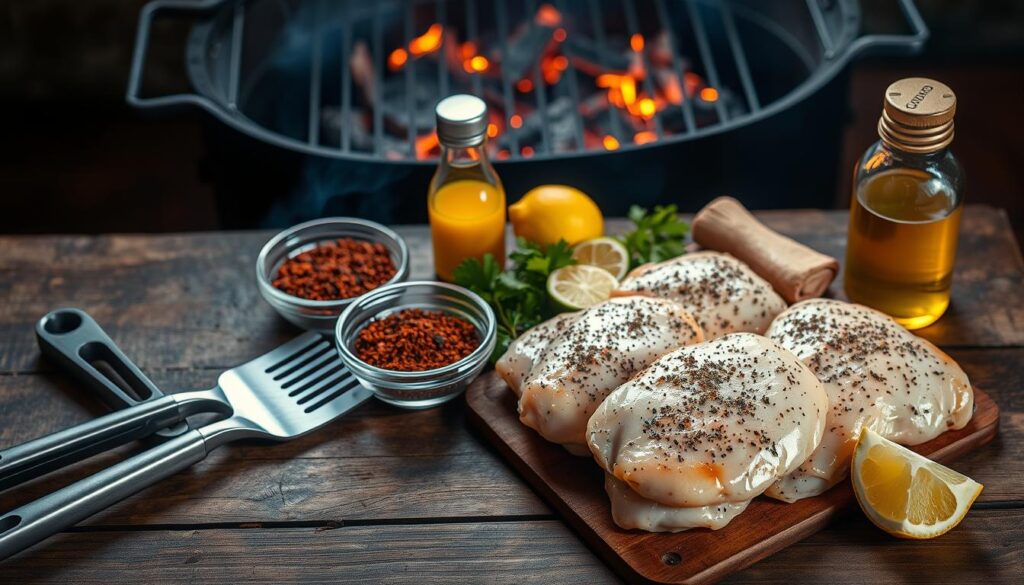Table of Contents
There’s nothing worse than dry, bland poultry ruining your summer cookout. We’ve all been there – staring at a plate of overcooked meat, wondering where it all went wrong. But what if you could master tender, mouthwatering results every single time?
This guide unlocks the secrets to creating unforgettable meals. You’ll learn how a simple marinade – think bright lemon zest paired with rich olive oil – transforms basic ingredients into something extraordinary. We’ll show you how to prep cuts for even cooking and achieve those restaurant-quality grill marks you’ve always admired.
Whether you’re hosting a backyard gathering or whipping up quick weeknight dinners, these methods adapt effortlessly. Serve your masterpiece on a toasted bun, slice it over crisp greens, or pair it with seasonal sides. The techniques work for novices and seasoned cooks alike, blending simplicity with professional-grade results.
Ready to elevate your skills? Let’s dive into the tools, timing, and little-known tricks that make all the difference. Your journey to perfectly charred, succulent dishes starts here.
Introduction to Grilled Chicken Excellence
Transform ordinary meals into culinary masterpieces with high-heat cooking methods that lock in natural juices. Unlike other techniques, grilling creates caramelized exteriors while preserving tenderness inside – a balance that turns basic proteins into crave-worthy dishes.
Discover the Benefits of Grilling
A properly heated surface works like magic. It sears meat quickly, forming those distinctive char lines that add smoky depth. This method also reduces excess fat, making meals lighter without sacrificing taste.
Quality matters from start to finish. Fresh lemon juice brightens flavors, while minced garlic infuses aromatic richness. Combine these with olive oil and cracked pepper for a marinade that tenderizes as it seasons.
Preheating your equipment ensures even heat distribution. Closing the lid traps convection currents, cooking food faster and preventing dryness. You’ll spend less time babysitting flames and more enjoying your gathering.
Upcoming sections break down each step – from selecting cuts to managing temperatures. Whether you’re crafting zesty salads or hearty bowls, these strategies guarantee consistent, restaurant-worthy results with minimal effort.
Why Grilled Chicken is a Must-Try Dish
Juicy, flavorful meals don’t require complicated methods—just smart strategies. Families and food lovers alike gravitate toward dishes that balance simplicity with bold taste. A well-prepared main course becomes the star of summer gatherings, picnics, and weeknight dinners effortlessly.
Simple Techniques for Maximum Flavor
Start by ensuring even thickness across your cuts. Lightly pounding meat creates uniform surfaces, preventing dry spots while locking in moisture. This step takes seconds but guarantees consistent results every time.
A balanced marinade works wonders. Combine olive oil with minced garlic, cracked pepper, and a pinch of salt. Letting the mixture soak into the meat for 30 minutes infuses layers of savory depth without overpowering natural flavors.
Timing is everything. Cook your protein 6-8 minutes per side over medium heat—any longer risks toughness. Use visual cues: golden grill marks signal perfect doneness. Resting the meat briefly before slicing preserves its juices.
These methods prove that small details create extraordinary meals. Whether you’re hosting friends or feeding a hungry family, mastering these steps turns basic ingredients into something memorable.
Preparing Your Chicken: Pounding, Brining, and Marinating
Great results begin before your protein touches the grill. Three techniques transform uneven cuts into juicy, flavorful masterpieces: precise shaping, strategic brining, and flavor-packed marinating.
Pounding for Even Thickness
Uneven pieces cook at different rates. Place boneless cuts between plastic wrap or in a zip-lock bag. Gently flatten them with a meat mallet or rolling pin until uniformly thick.
This step prevents overcooked edges while keeping centers tender. Aim for ½-inch thickness across the entire surface for consistent results.
Marinade Secrets and Brine Tips
Brining boosts moisture retention. Mix ¼ cup salt and 2 tbsp sugar in 4 cups water. Soak meat for 1 hour, then rinse thoroughly.
For marinades, combine these in a bowl:
| Ingredient | Purpose | Quantity |
|---|---|---|
| Lemon zest | Bright acidity | 1 tbsp |
| Minced garlic | Savory depth | 3 cloves |
| Olive oil | Tenderizing base | ½ cup |
| Cracked pepper | Spice balance | 1 tsp |
Marinate in the fridge 4-12 hours. Use a sealed container to prevent leaks. Pat meat dry before cooking to ensure perfect searing.
Essential Grilled Chicken Recipes

Diverse cuts demand tailored techniques to shine on the grill. Whether you’re working with lean breasts or rich thighs, small adjustments in prep and timing make all the difference. Let’s explore methods that guarantee succulent results across every variation.
Juicy Chicken Breasts and More
Start with a base marinade to elevate simple ingredients. Combine these components for optimal flavor:
| Ingredient | Amount | Role |
|---|---|---|
| Olive oil | ½ cup | Tenderizes & prevents sticking |
| Lemon juice | 3 tbsp | Balances richness |
| Brown sugar | 1 tbsp | Promotes caramelization |
| Garlic powder | 2 tsp | Adds depth |
Marinate breasts for 30-45 minutes only – longer soaking can create mushiness. Grill over medium heat 6-7 minutes per side. Let rest 5 minutes before slicing to preserve juices.
Adapting Recipes for Different Cuts
Thighs and drumsticks need modified approaches. Their higher fat content requires longer cooking at slightly lower heat. Use this guide:
| Cut | Marinade Time | Grill Temp | Cook Time |
|---|---|---|---|
| Breasts | 30-45 min | Medium | 12-14 min |
| Thighs | 1-2 hours | Medium-low | 18-20 min |
| Drumsticks | 2-3 hours | Low | 22-25 min |
For skinless options, reduce cook time by 15% to prevent dryness. Double the marinade quantity when preparing larger batches. A pinch of smoked paprika adds complexity to darker meats.
Experiment with herb combinations or citrus substitutions. The core method remains reliable – precise timing and quality oil ensure mouthwatering outcomes every time.
Tips for Achieving Perfect Grill Marks and Flavor
Crisp, defined grill marks aren’t just eye candy – they’re flavor amplifiers. Mastering this art requires precise heat control and smart techniques. Let’s break down the steps to create restaurant-worthy results in your backyard.
Preheating Your Grill for a Hot Start
Fire up your equipment 15 minutes early. This ensures even heat distribution across the grates. Aim for 400-450°F – use an infrared thermometer for accuracy.
Oil the grates right before cooking. Fold a paper towel, dip it in vegetable oil, and rub it across the surface. This prevents sticking while creating clean sear lines.
Managing Heat for a Tender Finish
Create two cooking zones: direct high heat for searing and indirect medium heat for finishing. Place your meat over the hot zone first. Let it sit undisturbed for 3-4 minutes per side to develop marks.
Use tongs to flip in one confident motion. Avoid shifting the meat once placed – this smudges the pattern. Move pieces to the cooler zone if edges darken too quickly.
Internal temperature matters most. Pull your protein off at 160°F – residual heat will carry it to 165°F safely. Let it rest 5 minutes before slicing to lock in juices.
Tools, Ingredients, and Equipment You’ll Need

The right tools transform kitchen chaos into culinary confidence. Proper prep equipment cuts down on last-minute scrambles and ensures your focus stays on flavor. Let’s explore what’s essential for success.
Must-Have Kitchen Tools
Start with a sturdy mixing bowl – it holds marinades without leaks and lets you toss ingredients evenly. A meat mallet tenderizes cuts quickly, creating uniform thickness for even cooking. Measuring cups and spoons ensure precise ratios of spices and oils.
Zip-lock bags work wonders for marinating. They save space in your fridge and let you massage flavors into the meat effortlessly. Don’t forget long-handled tongs – they keep your hands safe from flare-ups while flipping pieces.
Quality Ingredients to Elevate Taste
Fresh garlic and lemon zest add bright, aromatic notes that bottled versions can’t match. Opt for coarse sea salt – its texture helps it cling better during seasoning. A high-quality olive oil forms the base of marinades, carrying flavors deep into the meat.
Skinless cuts absorb marinades faster while staying juicy. Pre-measured spice blends save time, but freshly ground pepper and smoked paprika deliver superior depth. Always check expiration dates on powders – stale seasonings dull your dish.
Set timers for marinating and cooking phases. Just 30 minutes per side makes a difference between good and exceptional results. With these tools and ingredients prepped, you’re minutes away from a standout meal.
Creative Serving and Side Dish Ideas
Your masterpiece deserves a stage that matches its flavor. Pairing techniques and presentation choices turn simple meals into memorable dining experiences. Let’s explore ways to showcase your work while keeping textures and temperatures ideal.
Fresh Salads and Vibrant Sides
Slice cooked breasts diagonally for visual appeal. Fan the pieces over a bed of mixed greens, cherry tomatoes, and shaved carrots. Drizzle with a lemon-olive oil dressing (3 parts oil to 1 part citrus) for brightness.
Try these crowd-pleasing accompaniments:
| Side Dish | Prep Time | Key Ingredients |
|---|---|---|
| Grilled Veggie Bowl | 15 minutes | Zucchini, bell peppers, garlic |
| Quinoa Salad | 20 minutes | Lemon juice, olive oil, fresh herbs |
| Honey-Glazed Carrots | 12 minutes | Butter, brown sugar, cracked pepper |
Keep proteins warm by tenting foil over them while prepping sides. Use the grill’s cooler zone to gently heat bread or roasted potatoes. For cold dishes, chill serving bowls beforehand – this maintains crispness longer.
A sprinkle of flaky salt or citrus zest adds final flair. Mix textures: pair creamy coleslaw with crunchy cucumber ribbons. Remember, even small touches like arranging herbs as garnish elevate the entire plate.
Storing, Freezing, and Reheating Techniques
Leftovers deserve as much care as the original meal. Proper handling preserves texture and flavor, letting you enjoy your creations days later. Follow these guidelines to keep dishes tasting fresh without compromising quality.
Easy Leftover Storage Tips
Cool cooked meat completely before storing. Place pieces in airtight containers, separating layers with parchment paper. This prevents sticking and maintains moisture. Refrigerate for up to 3-4 days or freeze for 3 months.
For freezing:
- Wrap individual portions tightly in foil
- Label with dates to track freshness
- Thaw overnight in the fridge – never at room temperature
Reheat using a microwave-safe bowl with 1-2 tbsp water or broth. Cover loosely to trap steam. Heat in 60-second intervals, flipping once, until internal temperature reaches 165°F. This method keeps meat tender.
Key considerations:
- Store chicken breasts separately for faster defrosting
- Add a pinch of salt or lemon juice when reheating to revive flavors
- Use within 1 hour of removing from refrigeration
Following exact timing matters – 2 minutes per side in a skillet restores crispness without drying. Balance leftover marinade with a teaspoon of sugar or garlic powder to enhance taste. With these steps, every bite stays as satisfying as day one.
Conclusion
Mastering tender, flavorful results starts with smart prep work. Pounding cuts to even thickness, brining for moisture, and marinating with bright citrus or aromatic garlic create a foundation for success. These steps ensure every bite stays juicy, whether you’re cooking breasts, thighs, or drumsticks.
Precision matters on the grill. Controlling heat zones and timing prevents overcooking while achieving those crisp grill marks that add smoky depth. Letting meat rest before slicing locks in natural juices, transforming simple ingredients into restaurant-quality dishes.
The right tools elevate your game. A meat mallet, thermometer, and quality olive oil make prep effortless. Pair these with fresh herbs and coarse salt to amplify flavors without overpowering your protein.
Leftovers stay tasty when stored properly. Cool meat completely before freezing in airtight containers. Reheat gently with a splash of broth to revive texture and taste.
Don’t shy away from creativity. Slice grilled pieces over grain bowls, toss into zesty salads, or layer on crusty bread. Each method showcases your skills while keeping meals exciting.
Bookmark this guide for your next cookout. With these techniques, you’ll turn basic ingredients into consistently delicious meals that impress every time. Happy grilling!



